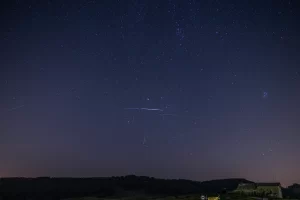Khushboo Malhotra
As summer slides into fall and the nights grow longer, the Sturgeon Moon made a big splash on August 11th, when it illuminated the sky and gave a rare celestial treat to stargazers around the world. Did you take a glimpse of the luminous fourth and final supermoon of 2022?
“This spectacular event was a glorious reminder of why we all love the night sky”
The August supermoon, the ‘Sturgeon Moon’, lit up skies around the world on August 11th-12th. This rare celestial treat gave stargazers and astronomy fans throughout the world a chance to watch the fourth and final supermoon of the year with their naked eyes, with the next supermoon set to occur in 2023.
The interestingly named supermoon gets its name from the Algonquin tribes of North America, as August’s full moon usually coincides with an abundance of sturgeon fish in their rivers and lakes. This spectacular event was a glorious reminder of why we all love the night sky. Interestingly, the event also coincided with another cosmic spectacle, the annual Perseid meteor shower, which occurred on the same night.

The ‘Sturgeon Moon’ reached its zenith in the early hours of Friday morning, appearing bigger than normal with orange hues as it lit skies around the globe. As seen in the southeast, the full Sturgeon supermoon rose at 8:55 pm on Thursday 11th August. It reached its peak at 2:36 am on 12th August.
“It is bigger. It is brighter, technically, but not so much that you’d walk outside and feel natural and instinctually something is super different,” Jackie Faherty, an astrophysicist at the American Museum of Natural History, told The New York Times. “That said, it is awesome to watch a full moon rise.”
In case you missed your chance to watch the supermoon, you can check the Virtual Telescope Project live stream event here. It is also available to watch on space.com or on CNN-News 18 YouTube.
Full Moon vs. Supermoon
The full moon is the lunar phase when the Moon appears fully illuminated from Earth, though there is still a dark section when there isn’t a lunar eclipse. It occurs every 29.5 days when the Sun, Earth and Moon align on an invisible 180-degree line. There are 12 full moons every year and all things being equal, they’d be equally phenomenal to watch.
“a supermoon can be 16% brighter than an ordinary full moon”
The Moon’s orbit is about 5 degrees different from the Earth’s, so it is usually a little higher or lower than Earth’s shadow, enabling the sun’s rays to illuminate the side facing the Earth. The next full Moon will occur on 10th September and is called the ‘Harvest Moon’. Traditionally, this moon acted as an aide to farmers harvesting their crops.
A supermoon is a full moon which appears slightly brighter and closer to the Earth than usual. A supermoon occurs when the Moon coincides with its ‘perigee’, the closest point to the Earth in its orbit. Each month, the Moon orbits the Earth in a slightly elliptical, egg-shaped path. This makes a supermoon bigger and brighter than other full moons.
At its most luminous, a supermoon can be 16% brighter than an ordinary full moon, which is noticeable, but not massively.
Astronomer and director of New York City’s Hayden Planetarium, Neil deGrasse Tyson tweeted his thoughts during last month’s even larger supermoon.
Tonight’s Full Moon, the largest of the year, is 8% larger than an average Full Moon. Will be called by some a “Super Duper Moon.”
I’m okay with that, but only if you think a 16-inch pizza is super-duper-sized compared with a 15-inch pizza. pic.twitter.com/mna7M93uFk
— Neil deGrasse Tyson (@neiltyson) July 13, 2022
As per a BBC report, The National Space Centre said it did not consider the ‘Sturgeon Moon’ to be close enough to the Earth to be called a ‘supermoon’. Although there is no official definition, it is said that supermoons must be closer than 360,000km. However, this moon was 361,408km away—much closer than the average Earth-Moon distance, but not quite close enough.
According to astrologer Richard Nolle’s definition, when a full moon or new moon is within 90 per cent of its closest point to Earth it is a supermoon. According to this scientific criteria, the Sturgeon Moon qualified as a supermoon since it was visible at 90 per cent of the perigee.
Supermoon Appearances in 2022
This year has seen many significant Moon appearances that have brought the world a chance to see the natural satellite illuminate the night sky. We have already witnessed three supermoons this year, in May, June and July, prior to the Sturgeon Moon, which was the fourth supermoon in a row.
Last month, the world saw the year’s largest supermoon, known as the Buck Moon or Thunder Moon. Before that, we witnessed the Strawberry Moon in June and the Flower Moon (which also featured a total lunar eclipse) in May.
Supermoon streaks like this are not uncommon. In 2023, we will witness four consecutive full supermoons, as will 2024. In 2025, we will have three supermoons in a row.
Sturgeon Moon: Through The Lens
Sky gazers enjoyed the fourth and final supermoon of 2022, the Super Sturgeon Moon—as seen from all over the globe. Photographers captured this rare lunar appearance alongside stunning landscapes, aeroplanes, and famous landmarks. Check out a few below:
Planes fly across a Sturgeon Moon in west London, the first being a Ryan Air flight from Shannon International to Budapest. The Sturgeon moon is 98% full with tomorrow night being a completely full moon.
.#sturgeonmoon #fullmoon #moon #aviation #planes #photojournalism pic.twitter.com/Mi7AWIZQwX— Joshua Bratt (@Joshbratt87) August 10, 2022
https://twitter.com/rapplerdotcom/status/1558372395907534849?s=20&t=_LWHAI2BtaVe_EnxXoPfXw
Featured image courtesy of Mike Petrucci on Unsplash. No changes were made to this image. Image license can be found here.

